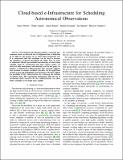Files in this item
Cloud-based e-Infrastructure for scheduling astronomical observations
Item metadata
| dc.contributor.author | Wetter, James Patrick | |
| dc.contributor.author | Akgun, Ozgur | |
| dc.contributor.author | Barker, Adam David | |
| dc.contributor.author | Dominik, Martin | |
| dc.contributor.author | Miguel, Ian James | |
| dc.contributor.author | Varghese, Blesson | |
| dc.date.accessioned | 2015-10-05T16:10:02Z | |
| dc.date.available | 2015-10-05T16:10:02Z | |
| dc.date.issued | 2015-08-31 | |
| dc.identifier | 220438974 | |
| dc.identifier | 3881455b-3605-4960-a6ba-e0910108ab95 | |
| dc.identifier | 84959050870 | |
| dc.identifier | 000380433500050 | |
| dc.identifier.citation | Wetter , J P , Akgun , O , Barker , A D , Dominik , M , Miguel , I J & Varghese , B 2015 , Cloud-based e-Infrastructure for scheduling astronomical observations . in 2015 IEEE 11th International Conference on e-Science (e-Science) (2015) . IEEE Computer Society , pp. 362-370 , 11th IEEE International Conference on eScience , Munich , Germany , 31/08/15 . https://doi.org/10.1109/eScience.2015.54 | en |
| dc.identifier.citation | conference | en |
| dc.identifier.other | ORCID: /0000-0001-9519-938X/work/33166293 | |
| dc.identifier.other | ORCID: /0000-0002-6930-2686/work/68281468 | |
| dc.identifier.other | ORCID: /0000-0002-3202-0343/work/75996785 | |
| dc.identifier.uri | https://hdl.handle.net/10023/7605 | |
| dc.description | This research was pursued under the EPSRC grant ‘Working Together: Constraint Programming and Cloud Computing’ (EP/K015745/1) and an Amazon Web Services (AWS) Education Research Grant. | en |
| dc.description.abstract | Gravitational microlensing exploits a transient phenomenon where an observed star is brightened due to deflection of its light by the gravity of an intervening foreground star. It is conjectured that this technique can be used to measure the abundance of planets throughout the Milky Way. In order to undertake efficient gravitational microlensing an observation schedule must be constructed such that various targets are observed while undergoing a microlensing event. In this paper, we propose a cloud-based e-Infrastructure that currently supports four methods to compute candidate schedules via the application of local search and probabilistic meta-heuristics. We then validate the feasibility of the e-Infrastructure by evaluating the methods on historic data. The experiments demonstrate that the use of on-demand cloud resources for the e-Infrastructure can allow better schedules to be found more rapidly. | |
| dc.format.extent | 1559640 | |
| dc.language.iso | eng | |
| dc.publisher | IEEE Computer Society | |
| dc.relation.ispartof | 2015 IEEE 11th International Conference on e-Science (e-Science) (2015) | en |
| dc.subject | QB Astronomy | en |
| dc.subject | QA75 Electronic computers. Computer science | en |
| dc.subject | QC Physics | en |
| dc.subject | NDAS | en |
| dc.subject.lcc | QB | en |
| dc.subject.lcc | QA75 | en |
| dc.subject.lcc | QC | en |
| dc.title | Cloud-based e-Infrastructure for scheduling astronomical observations | en |
| dc.type | Conference item | en |
| dc.contributor.sponsor | EPSRC | en |
| dc.contributor.institution | University of St Andrews. School of Computer Science | en |
| dc.contributor.institution | University of St Andrews. Centre for Interdisciplinary Research in Computational Algebra | en |
| dc.contributor.institution | University of St Andrews. School of Physics and Astronomy | en |
| dc.identifier.doi | 10.1109/eScience.2015.54 | |
| dc.identifier.url | http://www.computer.org/csdl/proceedings/escience/index.html | en |
| dc.identifier.grantnumber | EP/K015745/1 | en |
This item appears in the following Collection(s)
Items in the St Andrews Research Repository are protected by copyright, with all rights reserved, unless otherwise indicated.

